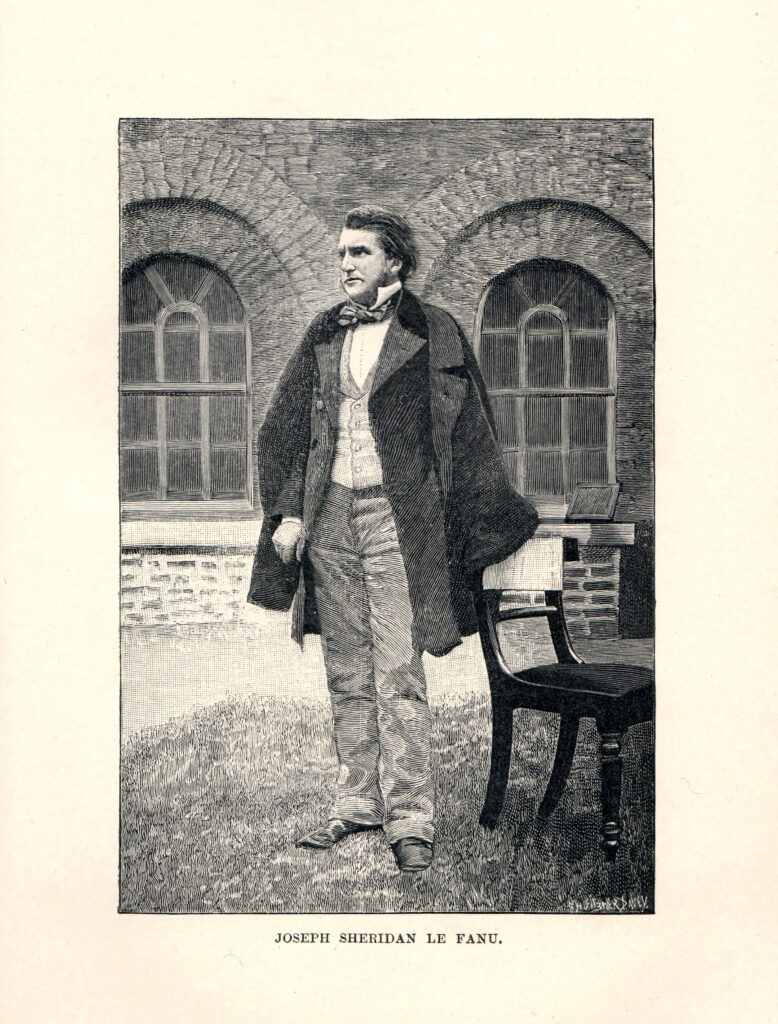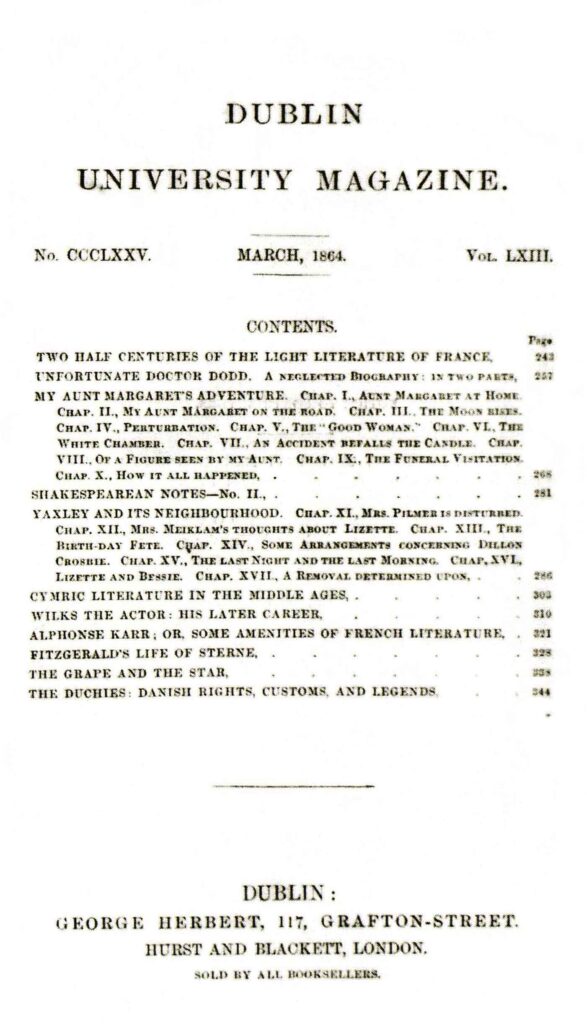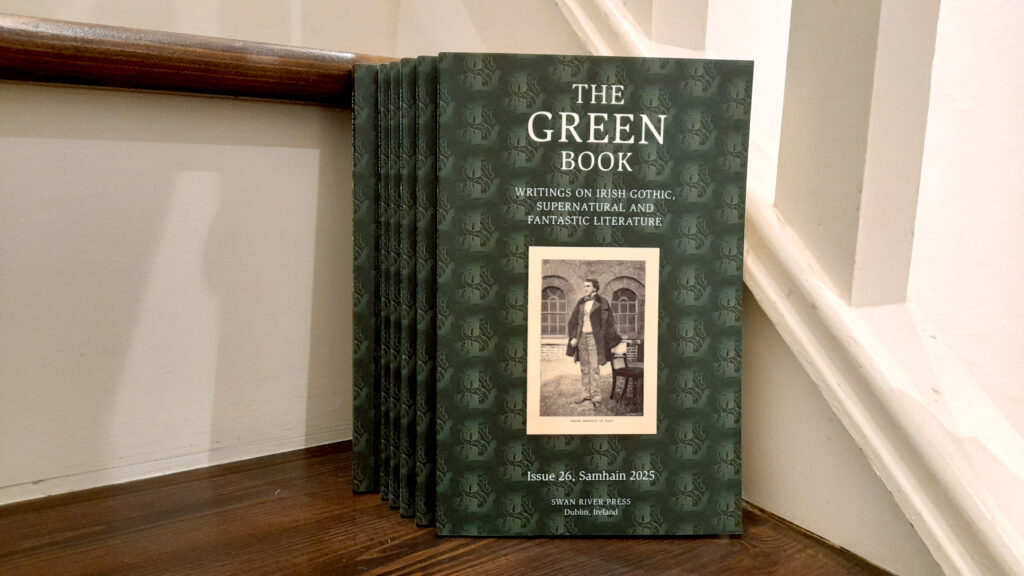 Editor’s Note #26
Editor’s Note #26
We find ourselves with a second issue this year focusing on Joseph Sheridan Le Fanu. I had a handful of items that I couldn’t fit into the previous issue, so I hope you’ll allow me the indulgence of a few more pages. There’s some interesting stuff between these covers.
The first piece is the subject of some debate among Le Fanu scholars. The story “My Aunt Margaret’s Adventure” was first published in the Dublin University Magazine (March 1864) between the final instalments of Wylder’s Hand (February) and “Wicked Captain Walshawe, of Wauling” (April). Along with “Wicked Captain Walshawe”, “My Aunt Margaret’s Adventure” was identified by M. R. James as having been written by Le Fanu—although authorship was not explicitly stated in its original publication of the story and no known records have surfaced to confirm this conjecture. At the time, James was compiling Madam Crowl’s Ghost and Other Tales of Mystery (1923). For that volume, James identified and reprinted a number of stories by Le Fanu that had until then been previously overlooked and uncollected, many of which were published anonymously in the first place. Although James does not state the basis upon which he draws the conclusion that “My Aunt Margaret’s Adventure” was written by Le Fanu, in a note to his prologue, he gives a definite reason for not including this tale in that volume: “[the story] belongs to a class of which I disapprove—the ghost-story which peters out into a natural explanation”.
Most scholars seem to agree that “My Aunt Margaret’s Adventure” was likely written by Le Fanu, although, as with “The Mysterious Lodger” (1850), and without firm evidence, there is ultimately a question mark beside its authorship. A Jamesian loophole of reasonable doubt. Swan River Press reprinted this story for the first time as a booklet in 2009. I’m pleased to include it again here. Once you’ve read this tale of Aunt Margaret and a sinister, remote road-side hostelry, you may draw your own conclusions.
 The second item in this issue is a real curiosity: the sole known piece of published writing by Le Fanu’s sister Catherine, a story entitled “The Botheration of Billy Cormack” (November 1840). Catherine was in her late twenties when this story was published in the Dublin University Magazine, where her brother’s “Purcell Papers” were by then already familiar to the magazine’s readers. Perhaps Catherine’s story was a first attempt at a burgeoning literary career? Did Le Fanu have a hand in guiding the story to publication? This career was tragically cut off when Catherline died in March 1841, less than half a year after the story was published. The tale is set in the west of Ireland—where Joseph, Catherine, and their brother William spent their adolescence—and it draws upon that region, evoking local colour and custom. To my knowledge, this is the first time the story has been reprinted.
The second item in this issue is a real curiosity: the sole known piece of published writing by Le Fanu’s sister Catherine, a story entitled “The Botheration of Billy Cormack” (November 1840). Catherine was in her late twenties when this story was published in the Dublin University Magazine, where her brother’s “Purcell Papers” were by then already familiar to the magazine’s readers. Perhaps Catherine’s story was a first attempt at a burgeoning literary career? Did Le Fanu have a hand in guiding the story to publication? This career was tragically cut off when Catherline died in March 1841, less than half a year after the story was published. The tale is set in the west of Ireland—where Joseph, Catherine, and their brother William spent their adolescence—and it draws upon that region, evoking local colour and custom. To my knowledge, this is the first time the story has been reprinted.
Similarly, William Le Fanu drew upon similar reminiscences when writing his sole book: Seventy Years of Irish Life (1893). In this memoir, William recalls his childhood, anecdotes concerning his brother Joseph, and his later career as a railroad engineer. For this issue, I’ve selected William’s memories of folklore and folk practices he encountered in his youth and on his travels throughout Ireland. For those seeking William Le Fanu’s memories of his older brother Joseph, extracts can be found reprinted in the excellent sourcebook Reflections in a Glass Darkly: Essays on J. Sheridan Le Fanu (2011); but if you’re more generally interested in Irish life and culture of by-gone days, do pick up a copy of Seventy Years of Irish Life. It’s still a charming read.
Rounding out this issue, we’ve two pieces relating to the death of Joseph Sheridan Le Fanu in February 1873. The first is a selection of obituaries, which I hope will give readers more insight as to Le Fanu’s stature and reputation at the time of his death, and how his writing was appreciated in that moment. I always find this sort of exercise fascinating because it’s the moment before obscuring mythologies take root around some authors, particularly if those authors in life revelled in horror and the gothic. And finally, we have a short piece on the now nearly-faded capstone of Le Fanu’s vault in Mount Jerome Cemetery, Dublin; and the memorial plaque that was subsequently installed for Le Fanu’s bicentenary in 2014—an attempt to stave off for a little longer the inevitable passage of time.
Brian J. Showers
Æon House, Dublin
28 August 2025


Looking forward to reading this. I know The Green Book isn’t a fiction anthology, but nonetheless a pertinent tale appearing in its covers here and there is very welcome.
Thanks, Tony. I hope you enjoy the issue!